Passcode Problems
I recently came across an instagram post with this image:
Pretty interesting, I was curious about the way this data was sourced and what methods were used, so I looked a bit into it. The data sourcing, analysis, visualization, and write up are from this fantastic article by Nick Berry. I highly suggest checking it out, especially if you’d like to see some great analysis on why certain numbers are likely.
Anyway, I was reading through it and thinking about the 4 digit pin number I am most familiar with in my life and that I see in the lives of so many people around me: my phone’s passcode.
Many people have a 4 digit pin which gives access to their iPhone, along with Face ID of course. But note that the 4 digit pin gives access to all the things you can use Face ID for. Also note that Face ID is not used as a backup if you don’t have the pin, but if you don’t have the face, the pin will get you access anyway. And there are some things (like when an iPhone is turned off and on) for which only the pin will give access.
So I was thinking about these pin number statistics and I was reminded of a news story from a while back, where there was a string of phone thefts at some music festivals. I remember thinking at the time, what a silly theft. I thought the value proposition was terrible because I assumed the thieves were going to try to sell the phones for parts at a low profit. But if they were able to unlock some of them, the value proposition becomes much larger. After seeing these statistics I got to thinking a new question which I think I can now estimate a decent answer to:
If you stole a backpack full of iPhones, how many could you expect to be able to unlock? (assuming they all have 4 digit pin passcodes which are randomly distributed amongst the aforementioned data)
Note: I’m ignoring android smartphones here because they are much less common in my demographic, and in the thefts I’m referring to. Also I know iPhones default to 5 guess attempts before a lockout, so it’s simpler for me to have consistent assumptions.
Now, to answer the question:
For each iPhone, you get 5 guesses at the passcode before the first lockout.
From the data given in the DataGenics article, you could choose the 5 most common pins to guess:
| PIN | Frequency | |
|---|---|---|
| 1 | 1234 | 10.713% |
| 2 | 1111 | 6.016% |
| 3 | 0000 | 1.881% |
| 4 | 1212 | 1.197% |
| 5 | 7777 | 0.745% |
If you add up those frequencies you get 20.552%.
Given my assumptions, you’d have a roughly 20% chance of unlocking a given iPhone, so for about every 5 iPhones, you’d expect to unlock 1!
I know this is an analysis constrained by certain (not too far fetched!) assumptions, but that number should be jarring! If you’re thinking that you use a 6 digit pin for your phone or that you use alphanumeric for your laptop, still please do take a moment to consider your passcodes/passwords! If it has some basis which you thought was kind of random or secret to you, the statistics here imply it might not be such a secret.
